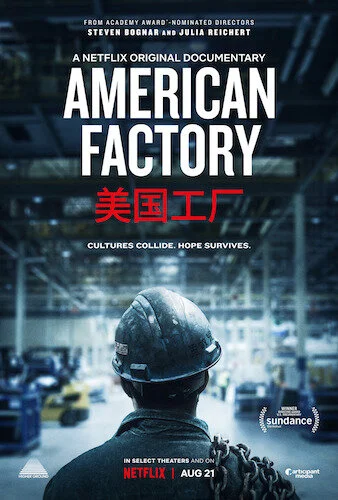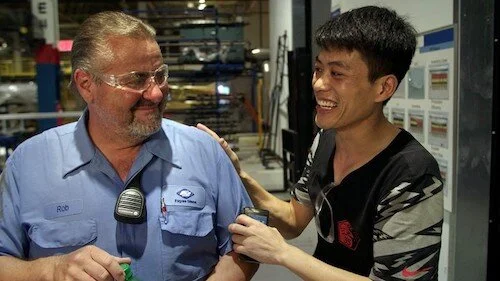American Factory
Please excuse our lateness of this review! We are covering every Academy Award nominee of 2020, so we’re cleaning up the films we forgot to critique earlier.
One thing we have learned about Barack Obama is that the former president of the United States has an amazing taste in film. With his annual best-of lists, you get an insight as to what blistering works resonated enough with him. These usually include documentaries, like Minding the Gap. So, it is absolutely no surprise that he and Michelle Obama started Higher Ground Productions: a producer tied to Netflix in order to fund films the Obamas see fit to help create. Their first work is the joint-effort by Steven Bognar and Julia Reichert known as American Factory: a multi year study of a closed GM plant turned into a Fuyao factory. I suppose neither Bognar nor Reichert knew where this story would take them, nor did the Obamas when they agreed to help produce.
The first half of American Factory is devoted to spotting the culture clashing between the American workers that have stuck by with the facility (to put food on the table) and the new Chinese employees brought in by Fuyao. The differences are cute, as long as everyone is getting along. Quickly, things get political, with some American workers being outwardly angry about the infusion of Chinese traditions and customs into their work place, and the Chinese ownership not accommodating the requests of these faithful workers. American Factory doesn’t like to point fingers and place the blame on either side. You see why these changes are so detrimental to the local workers, and why these changes are mandatory for the new employees working away from home. You’re just seeing the collision, here. No blatant favouritism here. It makes American Factory all the more sad.
American Factory details the problems with two drastically different cultures trying to operate one factory.
In the end, no real answers are given. Many answers are searched for, and these means are heavily recorded. There are trips to China to shed light on Fuyao’s intentions, rebellious strikes to create a union for security, the removal of break rooms for more work space, and testimonies by struggling workers (of either side) making their case to stay in this plant. Nothing really gets resolved. All we know from American Factory is that the world is really branched out politically, and that can be a major challenge in a working environment that everyone’s lives depend on. Leaning one way more than the other (no matter which way) is just not sustainable anymore.
We have to figure out a better way to blend policies, especially if this is the way of the future (before everything is done by robots, I guess). All of the tensions caused in American Factory are by people that all meant well from the start of this new path. Perhaps it is this neutral stance that the Obamas liked about the film, and their choice to produce it was a means of getting this evidence wide spread; maybe a Netflix user sitting at home has figured it out, after watching this footage. Maybe the next generation can use these warnings to make a difference. Right now, this Fuyao plant is just one of many instances where these tugs-of-war just aren’t working.
Andreas Babiolakis has a Masters degree in Film and Photography Preservation and Collections Management from Ryerson University, as well as a Bachelors degree in Cinema Studies from York University. His favourite times of year are the Criterion Collection flash sales and the annual Toronto International Film Festival.





